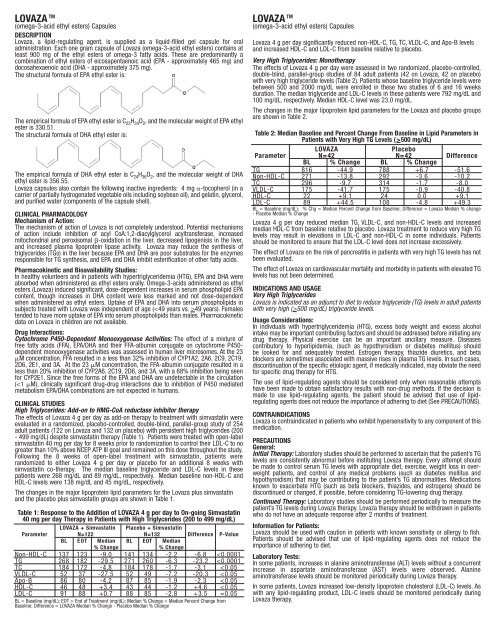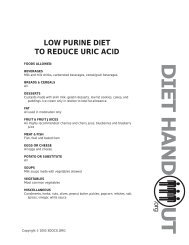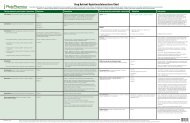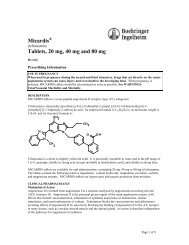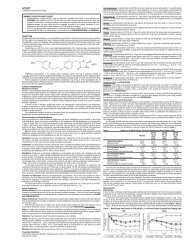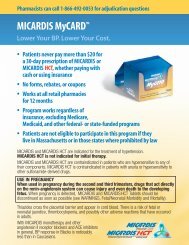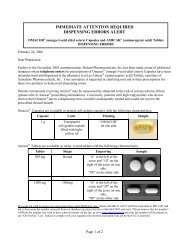Please see full prescribing information - Pharmacist eLink
Please see full prescribing information - Pharmacist eLink
Please see full prescribing information - Pharmacist eLink
Create successful ePaper yourself
Turn your PDF publications into a flip-book with our unique Google optimized e-Paper software.
LOVAZA TM(omega-3-acid ethyl esters) CapsulesDESCRIPTIONLovaza, a lipid-regulating agent, is supplied as a liquid-filled gel capsule for oraladministration. Each one gram capsule of Lovaza (omega-3-acid ethyl esters) contains atleast 900 mg of the ethyl esters of omega-3 fatty acids. These are predominantly acombination of ethyl esters of eicosapentaenoic acid (EPA - approximately 465 mg) anddocosahexaenoic acid (DHA - approximately 375 mg).The structural formula of EPA ethyl ester is:The empirical formula of EPA ethyl ester is C 22 H 34 O 2 , and the molecular weight of EPA ethylester is 330.51.The structural formula of DHA ethyl ester is:The empirical formula of DHA ethyl ester is C 24 H 36 O 2 , and the molecular weight of DHAethyl ester is 356.55.Lovaza capsules also contain the following inactive ingredients: 4 mg -tocopherol (in acarrier of partially hydrogenated vegetable oils including soybean oil), and gelatin, glycerol,and purified water (components of the capsule shell).CLINICAL PHARMACOLOGYMechanism of Action:The mechanism of action of Lovaza is not completely understood. Potential mechanismsof action include inhibition of acyl CoA:1,2-diacylglycerol acyltransferase, increasedmitochondrial and peroxisomal -oxidation in the liver, decreased lipogenisis in the liver,and increased plasma lipoprotein lipase activity. Lovaza may reduce the synthesis oftriglycerides (TGs) in the liver because EPA and DHA are poor substrates for the enzymesresponsible for TG synthesis, and EPA and DHA inhibit esterification of other fatty acids.Pharmacokinetic and Bioavailability Studies:In healthy volunteers and in patients with hypertriglyceridemia (HTG), EPA and DHA wereabsorbed when administered as ethyl esters orally. Omega-3-acids administered as ethylesters (Lovaza) induced significant, dose-dependent increases in serum phospholipid EPAcontent, though increases in DHA content were less marked and not dose-dependentwhen administered as ethyl esters. Uptake of EPA and DHA into serum phospholipids insubjects treated with Lovaza was independent of age (49 years). Femalestended to have more uptake of EPA into serum phospholipids than males. Pharmacokineticdata on Lovaza in children are not available.Drug Interactions:Cytochrome P450-Dependent Monooxygenase Activities: The effect of a mixture offree fatty acids (FFA), EPA/DHA and their FFA-albumin conjugate on cytochrome P450-dependent monooxygenase activities was assessed in human liver microsomes. At the 23M concentration, FFA resulted in a less than 32% inhibition of CYP1A2, 2A6, 2C9, 2C19,2D6, 2E1, and 3A. At the 23 M concentration, the FFA-albumin conjugate resulted in aless than 20% inhibition of CYP2A6, 2C19, 2D6, and 3A, with a 68% inhibition being <strong>see</strong>nfor CYP2E1. Since the free forms of the EPA and DHA are undetectable in the circulation(
LOVAZA TM(omega-3-acid ethyl esters) CapsulesDrug Interactions:Anticoagulants: Some studies with omega-3-acids demonstrated prolongation ofbleeding time. The prolongation of bleeding time reported in these studies has notexceeded normal limits and did not produce clinically significant bleeding episodes.Clinical studies have not been done to thoroughly examine the effect of Lovaza andconcomitant anticoagulants. Patients receiving treatment with both Lovaza andanticoagulants should be monitored periodically.HMG-CoA reductase inhibitors: In a 14-day study of 24 healthy adult subjects, dailyco-administration of simvastatin 80 mg with Lovaza 4 g did not affect the extent (AUC)or rate (C max ) of exposure to simvastatin or the major active metabolite, beta-hydroxysimvastatin at steady state.Cytochrome P450-Dependent Monooxygenase Activities: Omega-3-fatty acidcontaining products have been shown to increase hepatic concentrations of cytochromeP450 and activities of certain P450 enzymes in rats. The potential of Lovaza to induceP450 activities in humans has not been studied.Carcinogenesis, Mutagenesis, Impairment of Fertility:In a rat carcinogenicity study with oral gavage doses of 100, 600, 2000 mg/kg/day by oralgavage, males were treated with omega-3-acid ethyl esters for 101 weeks and femalesfor 89 weeks without an increased incidence of tumors (up to 5 times human systemicexposures following an oral dose of 4 g/day based on a body surface area comparison).Standard lifetime carcinogenicity bioassays were not conducted in mice.Omega-3-acid ethyl esters were not mutagenic or clastogenic with or without metabolicactivation in the bacterial mutagenesis (Ames) test with Salmonella typhimurium andEscherichia coli or in the chromosomal aberration assay in Chinese hamster V79 lung cellsor human lymphocytes. Omega-3-acid ethyl esters were negative in the in vivo mousemicronucleus assay.In a rat fertility study with oral gavage doses of 100, 600, 2000 mg/kg/day, males weretreated for 10 weeks prior to mating and females were treated for 2 weeks prior to andthroughout mating, gestation and lactation. No adverse effect on fertility was observed at2000 mg/kg/day (5 times human systemic exposure following an oral dose of 4 g/daybased on a body surface area comparison).Pregnancy Category C:There are no adequate and well-controlled studies in pregnant women. It is unknownwhether Lovaza can cause fetal harm when administered to a pregnant woman orcan affect reproductive capacity. Lovaza should be used during pregnancy only if thepotential benefit justifies the potential risk to the fetus.Omega-3-acid ethyl esters have been shown to have an embryocidal effect in pregnantrats when given in doses resulting in exposures 7 times the recommended human dose of4 g/day based on a body surface area comparison.In female rats given oral gavage doses of 100, 600, 2000 mg/kg/day beginning two weeksprior to mating and continuing through gestation and lactation, no adverse effects wereobserved in the high dose group (5 times human systemic exposure following an oral doseof 4 g/day based on body surface area comparison).In pregnant rats given oral gavage doses of 1000, 3000, 6000 mg/kg/day from gestationday 6 through 15, no adverse effects were observed (14 times human systemic exposurefollowing an oral dose of 4 g/day based on a body surface area comparison).In pregnant rats given oral gavage doses of 100, 600, 2000 mg/kg/day from gestation day14 through lactation day 21, no adverse effects were <strong>see</strong>n at 2000 mg/kg/day (5 times thehuman systemic exposure following an oral dose of 4 g/day based on a bodysurface area comparison). However, decreased live births (20% reduction) and decreasedsurvival to postnatal day 4 (40% reduction) were observed in a dose-ranging study usinghigher doses of 3000 mg/kg/day (7 times the human systemic exposure following an oraldose of 4 g/day based on a body surface area comparison).In pregnant rabbits given oral gavage doses of 375, 750, 1500 mg/kg/day from gestationday 7 through 19, no findings were observed in the fetuses in groups given 375 mg/kg/day(2 times human systemic exposure following an oral dose of 4 g/day based on a bodysurface area comparison). However, at higher doses, evidence of maternal toxicity wasobserved (4 times human systemic exposure following an oral dose of 4 g/day based on abody surface area comparison).Nursing Mothers:It is not known whether omega-3-acid ethyl esters are excreted in human milk. Becausemany drugs are excreted in human milk, caution should be exercised when Lovaza isadministered to a woman who is breastfeeding.Pediatric Use:Safety and effectiveness in pediatric patients under 18 years of age have not beenestablished.Geriatric Use:A limited number of patients over 65 years of age were enrolled in the clinical studies.Safety and efficacy findings in subjects over 60 years of age did not appear to differ fromthose of subjects less than 60 years of age.ADVERSE REACTIONSTreatment-emergent adverse events reported in at least 1% of patients treated withLovaza 4 g per day or placebo during 8 randomized, placebo-controlled, double-blind,parallel-group studies for HTG are listed in Table 3. Adverse events led to discontinuationof treatment in 3.5% of patients treated with Lovaza and 2.6% of patients treated withplacebo.LOVAZA TM(omega-3-acid ethyl esters) CapsulesTable 3: Adverse Events in Randomized, Placebo-Controlled, Double-Blind, Parallel-Group Studies for Very High TG Levels (> 500 mg/dL) that Used LOVAZA 4 g per DayLOVAZA Placebo*BODY SYSTEM (N = 226) (N = 228)Adverse Event n % n %Subjects with at least 1 adverse event 80 35.4 63 27.6Body as a wholeBack pain 5 2.2 3 1.3Flu syndrome 8 3.5 3 1.3Infection 10 4.4 5 2.2Pain 4 1.8 3 1.3CardiovascularAngina pectoris 3 1.3 2 0.9DyspepsiaEructationDigestive7113.14.9652.62.2SkinRash 4 1.8 1 0.4Special sensesTaste perversion 6 2.7 0 0.0Adverse events were coded using COSTART, version 5.0. Subjects were counted only once for eachbody system and for each preferred term.*Placebo was corn oil for all studies.Additional adverse events reported by 1 or more patients from 22 clinical studies for HTGare listed below:BODY AS A WHOLE: Enlarged abdomen, asthenia, body odor, chest pain, chills, suicide,fever, generalized edema, fungal infection, malaise, neck pain, neoplasm, rheumatoidarthritis, and sudden death.CARDIOVASCULAR SYSTEM: Arrhythmia, bypass surgery, cardiac arrest, hyperlipemia,hypertension, migraine, myocardial infarct, myocardial ischemia, occlusion, peripheralvascular disorder, syncope, and tachycardia.DIGESTIVE SYSTEM: Anorexia, constipation, dry mouth, dysphagia, colitis, fecalincontinence, gastritis, gastroenteritis, gastrointestinal disorder, increased appetite,intestinal obstruction, melena, pancreatitis, tenesmus, and vomiting.HEMATOLOGIC-LYMPHATIC SYSTEM: Lymphadenopathy.INFECTIONS AND INFESTATIONS: Viral infection.METABOLIC AND NUTRITIONAL DISORDERS: Edema, hyperglycemia, increased ALT, andincreased AST.MUSCULOSKELETAL SYSTEM: Arthralgia, arthritis, myalgia, pathological fracture, andtendon disorder.NERVOUS SYSTEM: Central nervous system neoplasia, depression, dizziness, emotionallability, facial paralysis, insomnia, vasodilatation, and vertigo.RESPIRATORY SYSTEM:laryngitis, pharyngitis, pneumonia, rhinitis, and sinusitis.SKIN: Alopecia, eczema, pruritus, and sweating.SPECIAL SENSES: Cataract.UROGENITAL SYSTEM:impotence.Asthma, bronchitis, increased cough, dyspnea, epistaxis,Cervix disorder, endometrial carcinoma, epididymitis, andDRUG ABUSE AND DEPENDENCELovaza does not have any known drug abuse or withdrawal effects.OVERDOSAGEIn the event of an overdose, the patient should be treated symptomatically, and generalsupportive care measures instituted, as required.DOSAGE AND ADMINISTRATIONPatients should be placed on an appropriate lipid-lowering diet before receiving Lovaza,and should continue this diet during treatment with Lovaza. In clinical studies, Lovaza wasadministered with meals.The daily dose of Lovaza is 4 g per day. The daily dose may be taken as a single 4-g dose(4 capsules) or as two 2-g doses (2 capsules given twice daily).HOW SUPPLIEDLovaza (omega-3-acid ethyl esters) capsules are supplied as 1-gram transparent softgelatincapsules filled with light-yellow oil and bearing the designation REL900 in bottlesof 60 (NDC 65726-425-15) and 120 (NDC 65726-425-27).Recommended Storage:Store at 25°C (77°F); excursions permitted to 15°-30°C (59°-86°F) [<strong>see</strong> USP ControlledRoom Temperature]. Do not freeze. Keep out of reach of children.Rx onlyRevised: June 2007Distributed by:Reliant Pharmaceuticals, Inc.Liberty Corner, NJ 07938Address Medical Inquiries to:Reliant Medical Inquiriesc/o PPD2655 Meridian ParkwayDurham, NC 27713-2203or Call: 877-311-75154251F-1214251012PRINTED IN USA© 2007 Reliant Pharmaceuticals, Inc.


